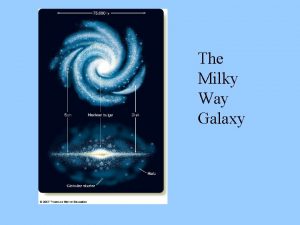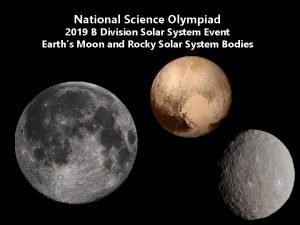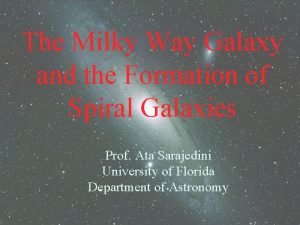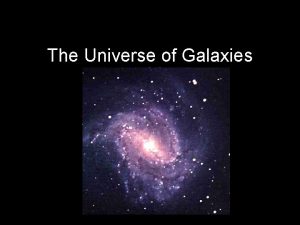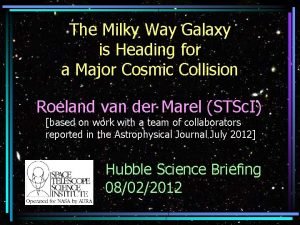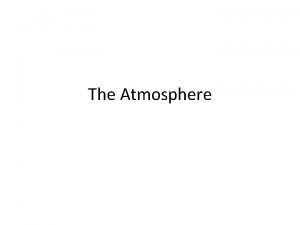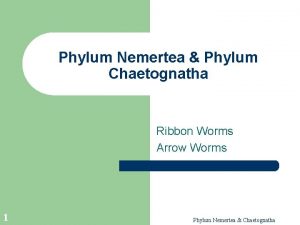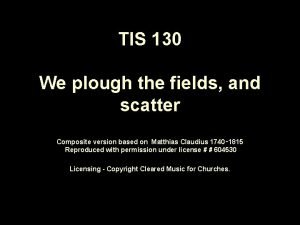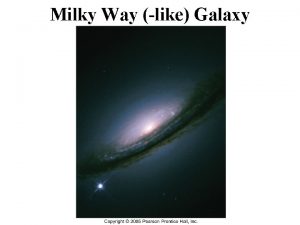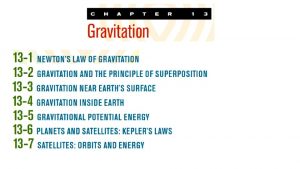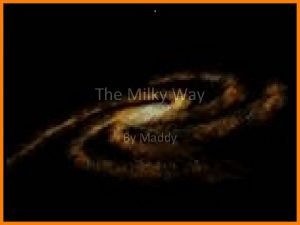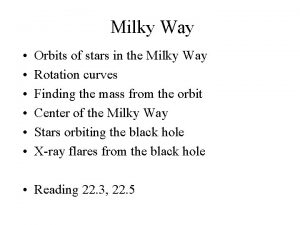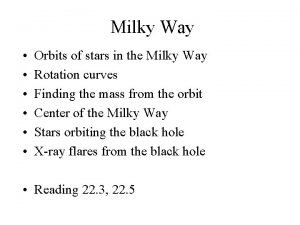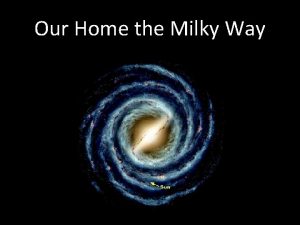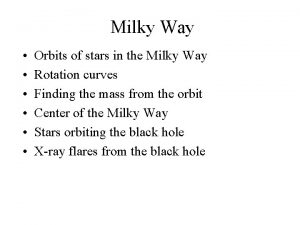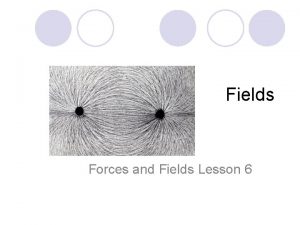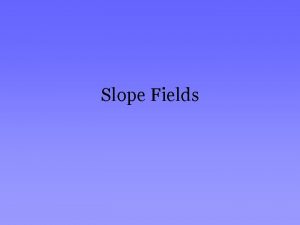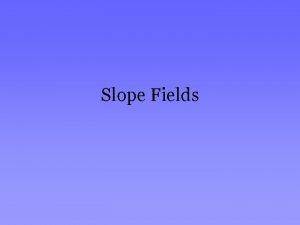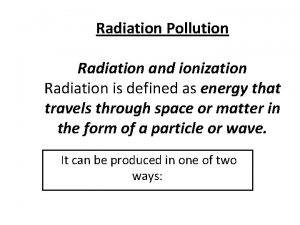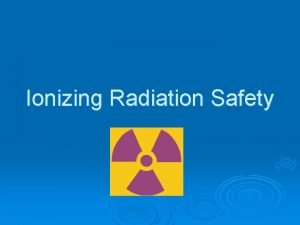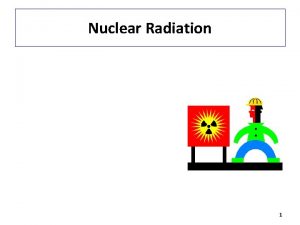Radiation fields in the Milky Way and their

































- Slides: 33

Radiation fields in the Milky Way and their role in High-Energy Astrophysics ESA, Planck HFI & LFI Consortia Richard Tuffs, Ruizhi Yang, & Felix Aharonian (MPI-Kernphysik Heidelberg) Cristina Popescu & Giovanni Natale (Jeremiah Horrocks Institute, Preston)

External Galaxy (NGC 891) - diffuse FIR traces luminosity of young and old stars (especially 100 -200 micron) => HE & VHE Inverse Compton - Diffuse submm traces dust (and gas) column (850 micron with Planck) => HE & VHE pion-decay emission - 25 and 60 micron: Compact SF regions trace UV emissivity (especially 25 & 60 micron)

Radiation Transfer Calculation: Model Geometry (Generic) (follows Popescu et al. 2011)

silicate inner disk - axisymmetric RT calculation with full treatment of anisotropic scattering and non-equilibrium thermal dust emission Silicate outer disk - RT in diffuse ISM uses dust model of Weingartner & Draine 2001 (calibrated on local Cirrus) - MIR/FIR/submm emission from SF regions described according to templates fixed empirically from observations of SF complexes in the Milky Way - A fraction F of UV allowed to freely escape from SF regions according to a geometric covering factor F - no use of CO and HI gas tracers - no use of stellar counts - Explicit fit of all geometric parameters, F and SFR and optical/NIR emissivities to dust emission in 850, 550, 350, 100, 60, 25 & 12 micron bands (Planck & IRAS) and to direct stellar light measured by COBE (4. 5 – 1. 2 micron) Popescu et al. (2000) graphite inner disk Graphite outer disk

- axisymmetric RT calculation with full treatment of anisotropic scattering and non-equilibrium thermal dust emission - RT in diffuse ISM uses dust model of Weingartner & Draine 2001 (calibrated on local Cirrus) - MIR/FIR/submm emission from SF regions described according to templates fixed empirically from observations of SF complexes in the Milky Way - A fraction F of UV allowed to freely escape from SF regions according to a geometric covering factor F - no use of CO and HI gas tracers - no use of stellar counts - Explicit fit of all geometric parameters, F and SFR and optical/NIR emissivities to dust emission in 850, 550, 350, 100, 60, 25 & 12 micron bands (Planck & IRAS) and to direct stellar light measured by COBE (4. 5 – 1. 2 micron) Fit to High Latitude Cirrus (Popescu et al. 2011)

- axisymmetric RT calculation with full treatment of anisotropic scattering and non-equilibrium thermal dust emission - RT in diffuse ISM uses dust model of Weingartner & Draine 2001 (calibrated on local Cirrus) - MIR/FIR/submm emission from SF regions described according to templates fixed empirically from observations of SF complexes in the Milky Way - A fraction F of UV allowed to freely escape from SF regions according to a geometric covering factor F - no use of CO and HI gas tracers Popescu et al. (2011) - no use of stellar counts - Explicit fit of all geometric parameters, F and SFR and optical/NIR emissivities to dust emission in 850, 550, 350, 100, 60, 25 & 12 micron bands (Planck & IRAS) and to direct stellar light measured by COBE (4. 5 – 1. 2 micron)

- axisymmetric RT calculation with full treatment of anisotropic scattering and non-equilibrium thermal dust emission - RT in diffuse ISM uses dust model of Weingartner & Draine 2001 (calibrated on local Cirrus) - MIR/FIR/submm emission from SF regions described according to templates fixed empirically from observations of SF complexes in the Milky Way - A fraction F of UV allowed to freely escape from SF regions according to a geometric covering factor F - no use of CO and HI gas tracers - no use of stellar counts - Explicit fit of all geometric parameters, F and SFR and optical/NIR emissivities to dust emission in 850, 550, 350, 100, 60, 25 & 12 micron bands (Planck & IRAS) and to direct stellar light measured by COBE (4. 5 – 1. 2 micron)

- axisymmetric RT calculation with full treatment of anisotropic scattering and non-equilibrium thermal dust emission - RT in diffuse ISM uses dust model of Weingartner & Draine 2001 (calibrated on local Cirrus) - MIR/FIR/submm emission from SF regions described according to templates fixed empirically from observations of SF complexes in the Milky Way - A fraction F of UV allowed to freely escape from SF regions according to a geometric covering factor F - no use of CO and HI gas tracers - no use of stellar counts - Explicit fit of all geometric parameters, F and SFR and optical/NIR emissivities to dust emission in 850, 550, 350, 100, 60, 25 & 12 micron bands (Planck & IRAS) and to direct stellar light measured by COBE (4. 5 – 1. 2 micron) Green et al. (2015) Using 8 million stars (Pan-STARRS 1)

- axisymmetric RT calculation with full treatment of anisotropic scattering and non-equilibrium thermal dust emission - RT in diffuse ISM uses dust model of Weingartner & Draine 2001 (calibrated on local Cirrus) - MIR/FIR/submm emission from SF regions described according to templates fixed empirically from observations of SF complexes in the Milky Way - A fraction F of UV allowed to freely escape from SF regions according to a geometric covering factor F - no use of CO and HI gas tracers - no use of stellar counts - Explicit fit of all geometric parameters, F and SFR and optical/NIR emissivities to dust emission in 850, 550, 350, 100, 60, 25 & 12 micron bands (Planck & IRAS) and to direct stellar light measured by COBE (4. 5 – 1. 2 micron)

60 micron 25 micron

850 micron Two dust disk structure found: (1) “Young” dust disk - scale length 3. 5 kpc - tapered: scale height varies from 50 to 80 pc from R=0 to R=8 kpc (2) “Old” dust disk - scale length 4. 9 kpc - constant scale height of 140 pc Face-on opacity of both disks decreases from R=4. 5 to R=0


Predicted Total Flux Predicted local Interstellar Radiation Field

Solution for diffuse Interstellar Radiation Field

Comparison with GALPROP solution for radiation fields

Effect of Radiation Fields on diffuse High Energy Inverse Compton Emission from the Milky Way Eb = 0. 01 Te. V Common reference energy spectrum d. N(E)/d. E = 5. 4 10^-12 (E/Ge. V)^(-3) exp(-E/Eb)cm^-2 s^-1 Ge. V^-1 (normalisation from the local electron flux measurements by Pamela at 10 Ge. V; Adriani et al. 2011) Eb = 10 Te. V

Volume within which ISRF component exceeds CMB component

Abramowski et al. (2014)

J 1641: E^-3. 14 energy spectrum; no cut off

J 1641: E^-2. 54 energy spectrum; no cut off

J 1641: E^-2. 54 energy spectrum (ISRF+CMB) with 100 Te. V cutoff (solid line) E^-3. 14 energy spectrum (ISRF+CMB) with no cutoff (dashed line)

Pair production opacity of the Milky Way Transmission curve for source at Galactic Centre Transmission curve for source at distance of 8 kpc and longitude 45 deg

ISRF Opacity for 40 Te. V photons from Extragalactic Sources

ESA, Herschel PACS & SPIRE Consortia

Fermi stacking analysis on 158 Cirrus clouds Planck dust column Fermi 1 -10 Ge. V Fermi 0. 1 -1 Ge. V Fermi 10 -100 Ge. V - Clouds selected from Planck dust column maps with |l| > 30 degrees - Fermi-LAT Pass 8 data over 7 years


MIR Radiation Fields in the inner 10 pc of the Milky Way towards Sgr A* HESS collaboration 2016 (see presentation by Aion Viana ) ring 0. 35 deg from Sgr A*

Spaceborne aperture photometry ISO-SWS (Lutz et al. 1996) MSX 19 micron

MSX 19 micron Inner 1. 2 x 1. 2 pc with 0. 02 pc FWHM VLT/VISIR 8. 6/11. 3/12. 8 micron (Viehmann et al. 2006) VLT/VISIR 19 micron (Viehmann et al. 2006)

Summary - An axisymmetric self consistent 2 dust-disk radiation transfer solution to the global morphology from 1. 2 to 850 micron exists - Predicted mid-plane ISRF high than before, especially in the central regions. IC scattering of the ISRF exceeds that off the CMB everywhere within the solar circle, with consequence for modelling both diffuse gamma-ray emission and gamma-rays from CR sources. - High latitude transclucent clouds (“Cirrus”) have been detected by Fermi/LAT from 0. 1 to 100 Gev, and are a likely source of high latitude Inverse Compton as well as pion emission - MIR/FIR Radiation fields within the inner 10 pc have been severely underestimated in the past and have the potential to constrain the geometry of central gamma-ray emitters via analysis of modulation of the VHE spectrum via pair-production opacity



PAH Silicate Graphite High latitude Cirrus
 Milky way description
Milky way description Where is the solar system located in the milky way
Where is the solar system located in the milky way Democritus milky way
Democritus milky way Science olympiad solar system
Science olympiad solar system Closest galaxy to milky way
Closest galaxy to milky way Dung beetle milky way
Dung beetle milky way What is the name
What is the name The milky way
The milky way Milky way galaxy sketch
Milky way galaxy sketch Milkyway fonterra
Milkyway fonterra Most galaxies in the inner region of a large cluster are
Most galaxies in the inner region of a large cluster are Red fields to green fields
Red fields to green fields 3 chemical properties of oxygen
3 chemical properties of oxygen Dj milky fabriky
Dj milky fabriky Chaetognatha diagram
Chaetognatha diagram Milky appearance of plasma
Milky appearance of plasma What's a frequency table
What's a frequency table Two way threaded binary tree
Two way threaded binary tree Perbedaan one way dan two way anova
Perbedaan one way dan two way anova Principles of conventional software engineering
Principles of conventional software engineering Perbedaan one way dan two way anova
Perbedaan one way dan two way anova One way two way anova
One way two way anova One way anova vs two way anova
One way anova vs two way anova Contoh one way anova dan two way anova
Contoh one way anova dan two way anova This way that way forwards backwards over the irish sea
This way that way forwards backwards over the irish sea Walk this way talk this way
Walk this way talk this way Words their way spelling test template
Words their way spelling test template Words their way online workshop
Words their way online workshop Words their way 2nd grade
Words their way 2nd grade Words their way power score chart
Words their way power score chart Is classwork one word
Is classwork one word Words their way esi
Words their way esi Electric forces and fields concept review
Electric forces and fields concept review Plough the fields and scatter
Plough the fields and scatter
